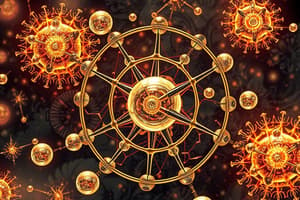Podcast
Questions and Answers
Which subatomic particle has a positive charge?
Which subatomic particle has a positive charge?
- Electron
- Alpha particle
- Proton (correct)
- Neutron
Which of the following is a non-metal element?
Which of the following is a non-metal element?
- Magnesium
- Copper
- Iron
- Sulfur (correct)
Which type of bond involves the sharing of electrons between atoms?
Which type of bond involves the sharing of electrons between atoms?
- Covalent bond (correct)
- Ionic bond
- Hydrogen bond
- Metallic bond
What is the difference between an ion and an isotope?
What is the difference between an ion and an isotope?
What type of reaction absorbs heat from its surroundings?
What type of reaction absorbs heat from its surroundings?
What is the function of electrons in an atom?
What is the function of electrons in an atom?
Which element is classified as a metalloid?
Which element is classified as a metalloid?
What is the difference between a physical and a chemical change?
What is the difference between a physical and a chemical change?
What is an ionic bond?
What is an ionic bond?
What is the process of balancing a chemical equation?
What is the process of balancing a chemical equation?
What is the function of protons in an atom?
What is the function of protons in an atom?
Which element is classified as a noble gas?
Which element is classified as a noble gas?
What is the difference between a cation and an anion?
What is the difference between a cation and an anion?
What is the difference between a physical and a chemical change?
What is the difference between a physical and a chemical change?
What is the difference between an ionic bond and a covalent bond?
What is the difference between an ionic bond and a covalent bond?
What is the difference between an isotope and an ion?
What is the difference between an isotope and an ion?
What is the definition of an exothermic reaction?
What is the definition of an exothermic reaction?
What is the difference between a metal and a non-metal element?
What is the difference between a metal and a non-metal element?
What is an isotope?
What is an isotope?
What is the function of a metalloid element?
What is the function of a metalloid element?
What is the difference between a covalent and an ionic bond?
What is the difference between a covalent and an ionic bond?
What is the function of neutrons in an atom?
What is the function of neutrons in an atom?
What is the difference between a metal and a non-metal element?
What is the difference between a metal and a non-metal element?
What is the difference between an ionic bond and a covalent bond?
What is the difference between an ionic bond and a covalent bond?
What is the function of the periodic table?
What is the function of the periodic table?
What is an endothermic reaction?
What is an endothermic reaction?
Flashcards are hidden until you start studying
Study Notes
Subatomic Particles
- Protons have a positive charge.
Elements
- Non-metal elements are a type of element that does not exhibit metal properties.
- Metalloid elements are intermediate in properties between metals and non-metals.
- Noble gas elements are a group of elements that do not readily react with other elements.
Chemical Bonds
- Covalent bonds involve the sharing of electrons between atoms.
- Ionic bonds involve the transfer of electrons between atoms, resulting in the formation of ions with opposite charges.
Ions and Isotopes
- Ions are atoms or groups of atoms with a positive (cation) or negative (anion) charge.
- Isotopes are atoms of the same element with the same number of protons but a different number of neutrons.
Chemical Reactions
- Endothermic reactions absorb heat from their surroundings.
- Exothermic reactions release heat to their surroundings.
Atoms
- Electrons have a negative charge and orbit the nucleus.
- Protons have a positive charge and are located in the nucleus.
- Neutrons have no charge and are located in the nucleus.
Chemical Equations
- Balancing a chemical equation involves making sure the number of atoms of each element is the same on both the reactant and product sides.
Periodic Table
- The periodic table is a tool used to organize elements based on their properties and relationships.
Physical and Chemical Changes
- Physical changes involve changes in state or phase, but not composition.
- Chemical changes involve changes in composition, resulting in a new substance.
Studying That Suits You
Use AI to generate personalized quizzes and flashcards to suit your learning preferences.




